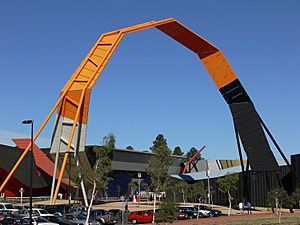National Museum of Australia facts for kids
 |
|
 |
|
| Established | 1980 |
|---|---|
| Location | Acton, Canberra, Australian Capital Territory, Australia () |
The National Museum of Australia (NMA) is in Canberra, Australia's capital city. It helps us understand Australia's history. The museum shows important events, people, and ideas that have shaped the nation. It was officially started in 1980.
The museum tells stories from 50,000 years of Aboriginal history. It also covers European settlement since 1788. Key moments like Federation and the Sydney 2000 Olympics are also explored. The NMA has the world's largest collection of Aboriginal bark paintings and stone tools. You can also see the heart of the famous racehorse Phar Lap and the first Holden car prototype. The museum creates and sends out exhibitions on many topics. These can range from bushrangers to surf lifesaving.
The museum uses new technology to share its stories with people everywhere. This is especially true for communities outside big cities. From 2003 to 2008, the museum hosted Talkback Classroom. This was a special forum where students could discuss political topics. The museum did not have its own building until March 11, 2001. That's when its special building officially opened. It is located on Acton Peninsula, next to the Australian National University. This area on Lake Burley Griffin used to be where the Royal Canberra Hospital stood.
Contents
Cool Building Design
The museum building was designed by architect Howard Raggatt. Its design is based on the idea of knotted ropes. This design shows how different Australian stories are connected. The architects wanted the building to show that Australia's story is not just one. Instead, it is many stories tangled together.
The building is like the center of a knot. Long "ropes" or strips extend from it. One of these strips forms a big loop. It then becomes a walkway that ends in a large curl. This part is called the "Uluru Axis." It lines up with the famous Uluru landmark in central Australia. This design connects the museum to the city plan and to Indigenous Australian culture.
The main entrance hall also follows this knot theme. The building looks like it was built around a complex knot that almost didn't fit. Then, the knot was removed. The building is not symmetrical. It uses bright colors, unusual angles, and surprising textures. It was designed to look different from a typical museum.
Design Ideas and Meanings
The building's design uses many ideas. It includes references to:
- Aboriginal Dreamtime stories, like the Rainbow Serpent creating the land.
- The idea that Australia's story is many stories tangled together.
The building also has parts that remind you of other famous buildings. For example, the main hall might make you think of the TWA Flight Center in New York. The "Garden of Australian Dreams" aims to show different ways of mapping the land. The walls even have parts of the word 'Eternity' written on them. This refers to Arthur Stace, who wrote this word on Sydney pavements for many years.
One part of the design caused some discussion. It looks like a zigzag pattern from the Jewish Museum Berlin in Germany. The architect said it was a "quotation" or reference, not a copy. The museum director said they did not know about this meaning when they approved the plan.
The outside of the building is covered in special aluminium panels. Many panels have words written in braille (a system of raised dots for blind people). Some words include "mate" and "she'll be right." Other messages were more sensitive, like "sorry." These sensitive messages have been covered with silver discs.
One braille phrase is "Resurrection city." This might refer to the old hospital being cleared for the museum. Or it could be about bringing together Indigenous Australians and European settlers. The building was finished in 2001.
Storm Damage and Repairs
On December 29, 2006, a big thunderstorm hit Canberra. It damaged the roof of the museum's office area. The ceiling fell because of the heavy hail. This caused water to get inside. However, the main museum building and its collections were safe. The museum reopened the next day. Repairs cost at least A$500,000.
New Additions in 2012-2013
In 2012, the museum started building a new cafe and an office wing. The new cafe opened in late 2012. It has great views of Lake Burley Griffin. It offers both indoor and outdoor dining. Moving the cafe made the large entry hall free for displaying big objects. These objects include vehicles from the museum's collection.
The new office wing was finished in mid-2013. It connects the main building to the older office building. This new building is covered in bright, colorful tiles. These tiles are arranged in a QR code pattern.
Amazing Collections
The museum's collection is called the National Historical Collection. It has over 210,000 objects! The collection focuses on three main areas:
- The culture and history of Aboriginal and Torres Strait Islander peoples.
- Australian history and culture since European settlement in 1788.
- How people interact with the Australian environment.
Some famous objects in the collection include:
- Items related to the death of Azaria Chamberlain, like a yellow Holden Torana car.
- Bicycles owned by Australian cyclist Cadel Evans, who won the 2011 Tour de France.
- Navigational instruments used by Captain James Cook.
- Medical tools used by eye doctor Fred Hollows.
- A Holey dollar, which was Australia's first official coin.
- Netball items from famous player Liz Ellis.
- Olympic medals won by John Konrads at the 1960 Rome Olympics.
- Props from the children's TV show Play School.
- An Australian flag found after the September 11 attacks in New York.
- The fleece of Chris the sheep, who had a record-breaking amount of wool.
The museum also helps return the remains of Indigenous Australians. These remains are often held in museums around the world. The NMA works to bring them back to their home communities. By March 2019, over 1,400 remains had been returned.
Past Exhibitions
The National Museum of Australia hosts many interesting exhibitions. Here are some of them:
Songlines: Tracking the Seven Sisters
This exhibition opened on September 15, 2017. It was about the creation myth of the Seven Sisters. This story is important to many Indigenous groups in Australia's Western and Central Deserts. The exhibition was created with Aboriginal elders who are the guardians of this Dreamtime story. It included a huge painting called Yarrkalpa — Hunting Ground. This painting showed the area around Parnngurr in Western Australia. It also showed the seasons and Indigenous ways of managing the land. In June 2022, this artwork was projected onto the Sydney Opera House during the Vivid Sydney festival. The exhibition ran until February 2018. It traveled to Berlin, Germany, in 2022 and to Paris, France, in 2023.
Other Exhibitions to Explore
- Museum Workshop: This exhibition looked at how conservators care for objects in the museum's collection (October 2012 – January 2013).
- Inside: Life in Children's Homes and Institutions: This show shared the stories of children who lived in institutional care (November 2011 – February 2012).
- Not Just Ned: A true history of the Irish in Australia: This exhibition explored the history and influence of Irish people in Australia (March–July 2011).
- Behind the Lines: The Year's Best Cartoons: This was a yearly exhibition showing the best Australian political cartoons (various dates, e.g., December 2010 – October 2011).
- Exploration and Endeavour: The Royal Society of London and the South Seas: This celebrated the 350th anniversary of the Royal Society and showed items from scientific voyages (September 2010 – February 2011).
- Papunya Painting: Out of the Australian Desert: This highlighted the museum's collection of Indigenous Western Desert art (June–August 2010).
- A Fine Yarn: Innovations in Australia's Wool Industry: This looked at the modern wool industry and its history in Australia (July–November 2009).
- Utopia: The Genius of Emily Kame Kngwarreye: This told the story of a great Australian contemporary artist (August–October 2008).
- Migration Memories: This explored migration stories from people in different regional towns (September–November 2007).
- Great Railway Journeys of Australia: This exhibition explored Australia's rail network and famous train journeys (April–August 2007).
- Miss Australia: A Nation's Quest: This traced the history of the Miss Australia competition from 1907 to 2000 (March–June 2007).
- Between the Flags: 100 Years of Surf Lifesaving: This celebrated 100 years of surf lifesaving in Australia (December 2006 – March 2007).
- Captivating and Curious: This displayed many different objects from the museum's collection (December 2005 – March 2006).
- Extremes: Survival in the Great Deserts of the Southern Hemisphere: This explored deserts in Southern Africa, South America, and Australia (December 2004 – August 2005).
- Royal Romance: This looked at Australia's reaction to Queen Elizabeth II's first visit in 1954 (February–October 2004).
- Nation: Symbols of Australia: This exhibition explored Australian history through symbols like the Hills Hoist clothes line (March 2001 – January 2010).
- Horizons: The Peopling of Australia since 1788: This traced stories of human movement and how immigration to Australia shaped the country (March 2001 – October 2007).
Awards and Recognition
The National Museum of Australia has won many awards. It was named Australia's Major Tourist Attraction in both 2005 and 2006. It also won the Canberra and Capital Region's Tourism Award for Major Tourist Attraction for five years in a row, from 2003 to 2007.
See also
 In Spanish: Museo Nacional de Australia para niños
In Spanish: Museo Nacional de Australia para niños
- HMS Investigator Anchors, its stream anchor is at the NMA
- PS Enterprise, an 1878 paddle steamer owned and operated by the Museum







